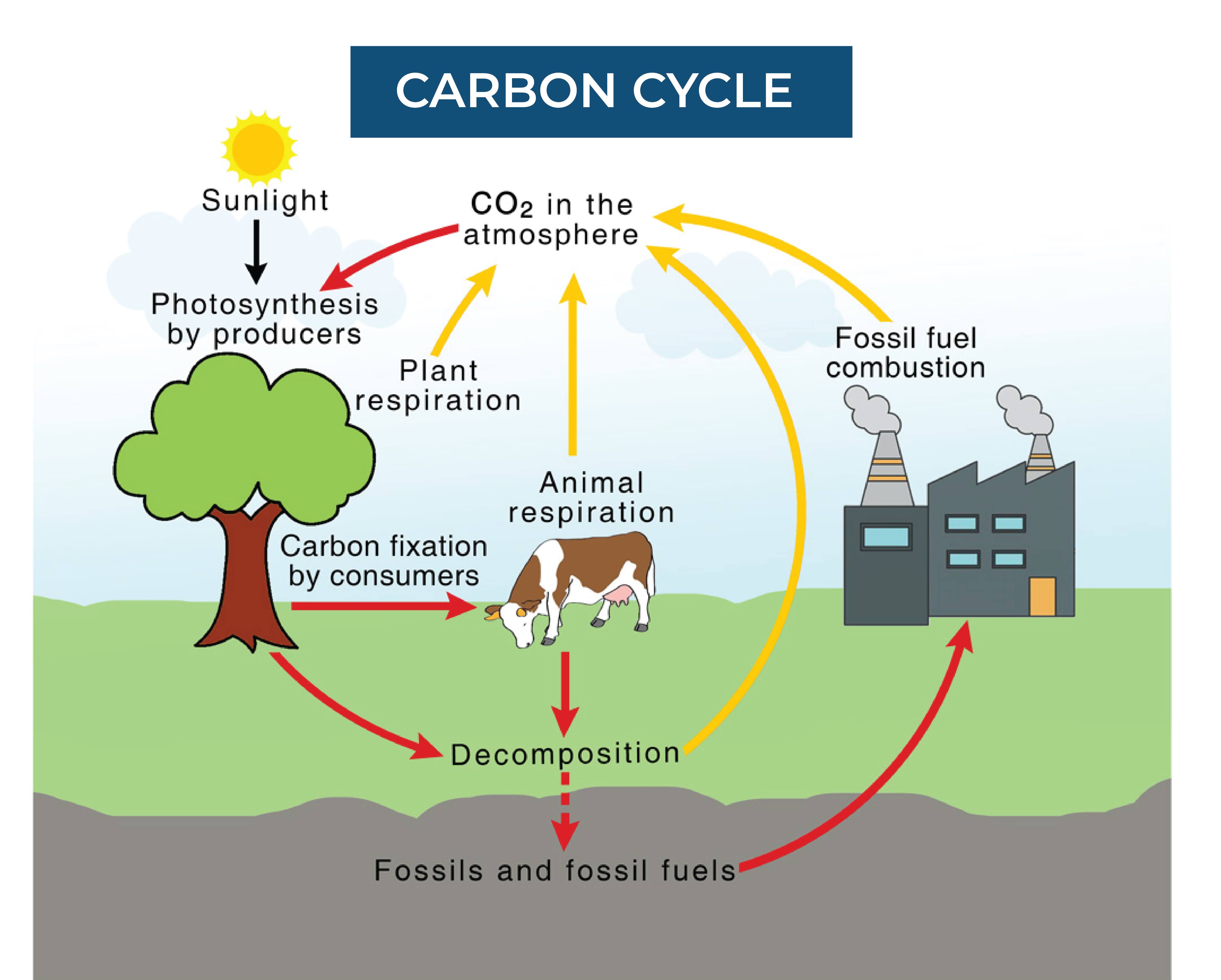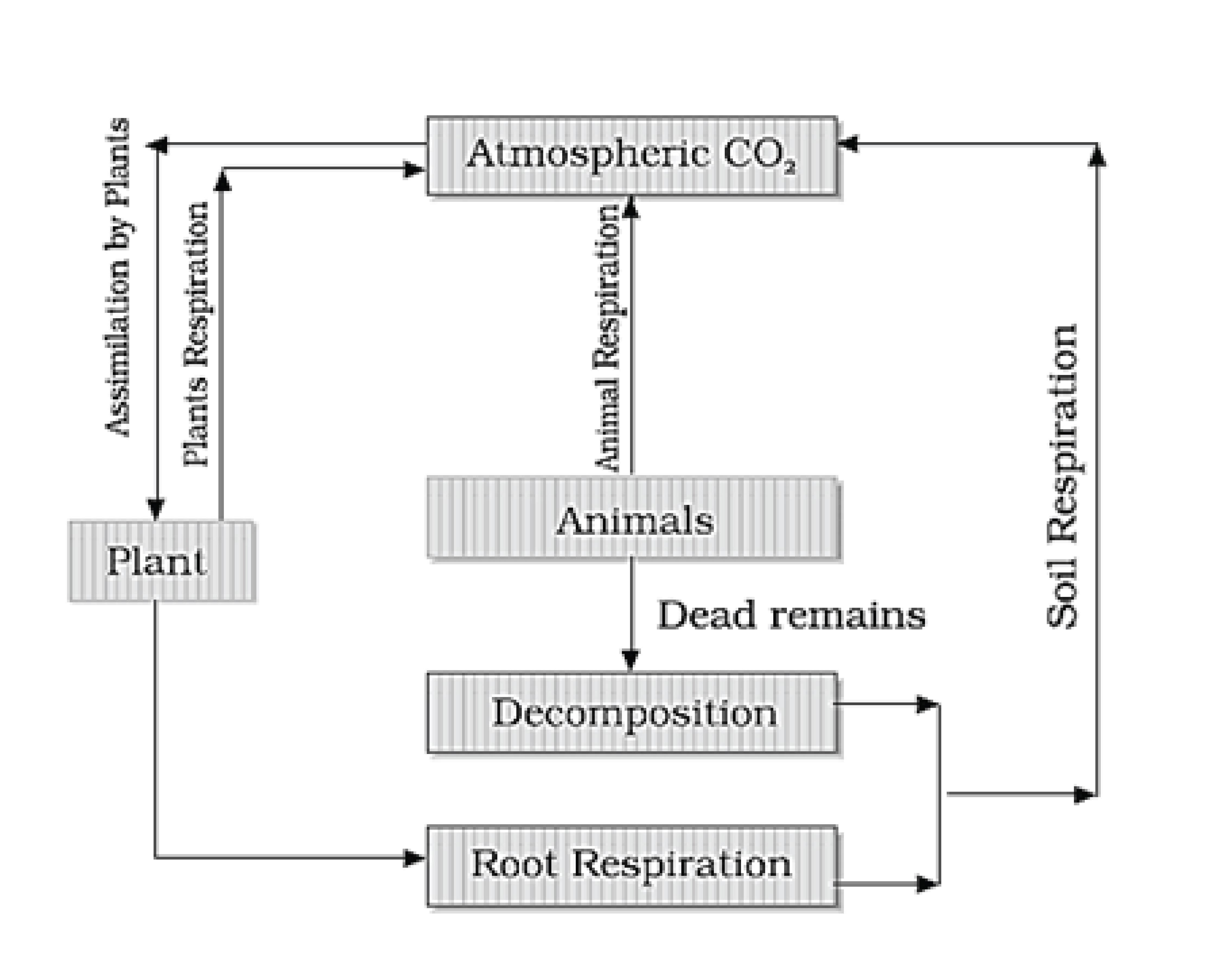The Carbon Cycle
Grade 7 Science Worksheets
Carbon is a chemical element, and is the basis of all known life on Earth. It is important in the ecosystem because it is a key building block of carbohydrates, fats, and proteins, which make up the structure of living organisms. Additionally, carbon is a part of the carbon cycle, which helps regulate the amount of carbon dioxide in the atmosphere, and thereby helps maintain the Earth’s climate.
Table of Contents:
- What is Carbon Cycle?
- Terrestrial Carbon Cycle
- Oceanic Carbon Cycle
- FAQs
The Carbon Cycle - Grade 7 Science Worksheet PDF
This is a free printable / downloadable PDF worksheet with practice problems and answers. You can also work on it online.
|
Untimed | |
Sign up with your email ID to access this free worksheet.
"We really love eTutorWorld!"
"We really love etutorworld!. Anand S and Pooja are excellent math teachers and are quick to respond with requests to tutor on any math topic!" - Kieran Y (via TrustSpot.io)
"My daughter gets distracted easily"
"My daughter gets distracted very easily and Ms. Medini and other teachers were patient with her and redirected her back to the courses.
With the help of Etutorworld, my daughter has been now selected in the Gifted and Talented Program for the school district"
- Nivea Sharma (via TrustSpot.io)
What is Carbon Cycle?
The carbon cycle is the process by which carbon is continuously cycled from the atmosphere into living organisms, the oceans, and the Earth’s crust, and then back into the atmosphere.

There are two main types of carbon cycles:
the terrestrial carbon cycle and the oceanic carbon cycle.
Terrestrial Carbon Cycle
The terrestrial carbon cycle refers to the exchange of carbon between the atmosphere, land-based ecosystems, and the Earth’s crust.

It includes the following processes:
Photosynthesis: During this process, plants use energy from sunlight to convert carbon dioxide from the air into organic matter, such as glucose.
Respiration: All living organisms, including plants, release carbon dioxide back into the atmosphere through respiration, where they convert organic matter back into energy.
Decomposition: Dead organic matter, such as fallen leaves and dead plants, is decomposed by microorganisms into simple compounds, including carbon dioxide.
Soil Carbon Storage: Some of the carbon released through respiration and decomposition is stored in the soil, where it can remain for decades to centuries.
Land Use Change: Human activities such as deforestation and agriculture can significantly alter the terrestrial carbon cycle by changing the amount of carbon stored in plants and soils and by releasing carbon dioxide into the atmosphere through burning of forests or the use of synthetic fertilizers.
These processes are in a state of dynamic balance, and changes in one can affect the others and the overall carbon balance. The terrestrial carbon cycle plays a critical role in regulating the amount of carbon dioxide in the atmosphere, and helps to maintain the Earth’s climate.
Here are some examples of the terrestrial carbon cycle:
Photosynthesis by trees and other plants, which converts carbon dioxide from the atmosphere into organic matter.
Decomposition of fallen leaves and dead plants, releasing carbon dioxide back into the atmosphere.
Respiration by plants, animals, and microorganisms, which releases carbon dioxide back into the atmosphere.
Soil carbon storage, where dead organic matter is transformed into soil organic matter and stored for long periods of time.
Deforestation, which removes trees and other vegetation, and reduces the amount of carbon stored in plants and soils.
Agricultural practices, such as tillage, which can release carbon stored in soils into the atmosphere.
Forest fires, which release large amounts of carbon dioxide into the atmosphere.
Reforestation, which increases the amount of carbon stored in vegetation and soil.
These processes are in a state of dynamic balance, and changes in one can affect the others and the overall carbon balance. The terrestrial carbon cycle plays a critical role in regulating the amount of carbon dioxide in the atmosphere, and helps to maintain the Earth’s climate.
“There have been times when we booked them last minute, but the teachers have been extremely well-prepared and the help desk at etutorworld is very prompt.
Our kid is doing much better with a higher score.”
7th Grade Tutoring
eTutorWorld offers Personalized Online Tutoring for Math, Science, English, and Standardised Tests.
Our Tutoring Packs start at just under $21 per hour, and come with a moneyback guarantee.
Schedule a FREE Trial Session, and experience quality tutoring for yourself. (No credit card required.)
Oceanic Carbon Cycle
The oceanic carbon cycle refers to the exchange of carbon between the ocean and the atmosphere. It includes the following processes:
Dissolution of CO2: Carbon dioxide in the atmosphere dissolves into the surface waters of the ocean, forming carbonic acid, which then splits into hydrogen ions and bicarbonate ions.
Transport by ocean currents: The ocean currents transport the dissolved carbon throughout the ocean, spreading it to different depths and latitudes.
Uptake by phytoplankton: Phytoplankton, tiny marine plants, use carbon dioxide during photosynthesis to make organic matter, just like land plants.
Sinking of organic matter: Some of the organic matter produced by phytoplankton sinks to the ocean floor, where it can be stored for centuries to thousands of years.
Release of CO2 through ocean ventilation: The deep ocean releases carbon dioxide back into the atmosphere through a process called ocean ventilation, where deep, cold water rises to the surface, bringing with it carbon dioxide that has been stored for centuries.
Release of CO2 from oceanic sediments: Carbon dioxide can also be released from the ocean floor by geological processes such as volcanic activity and tectonic movement.
These processes are in a state of dynamic balance, and changes in one can affect the others and the overall carbon balance. The oceanic carbon cycle plays a critical role in regulating the amount of carbon dioxide in the atmosphere, and helps to maintain the Earth’s climate.
Here are some examples of the oceanic carbon cycle:
Dissolution of carbon dioxide from the atmosphere into surface waters of the ocean.
Transport of dissolved carbon through ocean currents, such as the Gulf Stream, which carries warm water from the tropics towards the poles.
Uptake of carbon dioxide by phytoplankton during photosynthesis, which converts it into organic matter.
Sinking of phytoplankton-derived organic matter to the ocean floor.
Release of carbon dioxide from deep ocean water to the atmosphere through ocean ventilation, where deep, cold water rises to the surface.
Release of carbon dioxide from oceanic sediments due to volcanic activity and tectonic movement.
Absorption of carbon dioxide by the ocean during periods of low atmospheric carbon dioxide levels, such as during glacial periods.
These processes are in a state of dynamic balance, and changes in one can affect the others and the overall carbon balance. The oceanic carbon cycle plays a critical role in regulating the amount of carbon dioxide in the atmosphere, and helps to maintain the Earth’s climate.
Do You Stack Up Against the Best?
If you have 30 minutes, try our free diagnostics test and assess your skills.
The Carbon Cycle FAQS
What is the carbon cycle?
The carbon cycle is the continuous exchange of carbon between the atmosphere, land, and ocean, which helps regulate the Earth’s climate and maintain the balance of carbon dioxide in the atmosphere.
Why is the carbon cycle important?
The carbon cycle is important because it helps regulate the amount of carbon dioxide in the atmosphere, which affects the Earth’s climate and weather patterns.
How does the carbon cycle work?
The carbon cycle works through a series of processes, including photosynthesis, decomposition, respiration, soil carbon storage, and oceanic exchange of carbon, which work together to regulate the amount of carbon dioxide in the atmosphere.
What are the main components of the carbon cycle?
The main components of the carbon cycle are the atmosphere, land, and ocean, and the exchange of carbon between these components.
How does human activity affect the carbon cycle?
Human activity, such as deforestation, burning of fossil fuels, and land use changes, can increase the amount of carbon dioxide in the atmosphere and disrupt the balance of the carbon cycle.
What is the difference between the terrestrial and oceanic carbon cycles?
The terrestrial carbon cycle refers to the exchange of carbon between the land and the atmosphere, while the oceanic carbon cycle refers to the exchange of carbon between the ocean and the atmosphere.
How does the carbon cycle contribute to climate change?
The carbon cycle contributes to climate change by affecting the amount of carbon dioxide in the atmosphere, which affects the Earth’s temperature and weather patterns. Increased levels of carbon dioxide in the atmosphere due to human activities can result in a warmer climate.

Kathleen Currence is one of the founders of eTutorWorld. Previously a middle school principal in Kansas City School District, she has an MA in Education from the University of Dayton, Ohio. She is a prolific writer, and likes to explain Science topics in student-friendly language. LinkedIn Profile
Affordable Tutoring Now Starts at Just $22.49
eTutorWorld offers affordable one-on-one live tutoring over the web for Grades K-12. We are also a leading provider of Test Prep help for Standardized Tests (SCAT, CogAT, MAP, SSAT, SAT, ACT, ISEE, and AP).
What makes eTutorWorld stand apart are: flexibility in lesson scheduling, quality of hand-picked tutors, assignment of tutors based on academic counseling and diagnostic tests of each student, and our 100% money-back guarantee.
Whether you have never tried personalized online tutoring before or are looking for better tutors and flexibility at an affordable price point, schedule a FREE TRIAL Session with us today.
*There is no purchase obligation or credit card requirement
Grade 7 Science Worksheets
- Elements and Compounds
- Solar Energy
- Photosynthesis
- Electricity and Magnetism
- Law of conservation of energy
- Periodic table
- Properties of Matter
- Waves
- Energy Resources
- Weather and Climate
- Immune, Circulatory and Digestive Systems
- Organs in Multi-cellular Organism
- Sedimentary, Igneous, and Metamorphic Rocks
- Structure of the Earth
- Law of Conservation of Mass
- Physical and Chemical Changes
- Scientific Method
- Human Digestive System
- Environmental Science
- Renewable and Non-renewable energy Resources
- Characteristics of Living Organisms
- Life Science
- Earth and Space Science
- Solar Eclipse
- Heat Technology
- Newton’s Laws of Motions
- Physical Science
- Tools, Measurement and SI Units
- Earth Atmosphere
- Interactions of Living things
- The Earth Ecosystem
- Organelles in Plant and Animal cells
- Layers of the Earth
- Cycles in Nature
Grade 7 Math Worksheets
- Fractions
- Linear equations word problems
- Statistics
- Properties of Parallel Line
- Finding slope from an equation
- Identifying Quadrilaterals
- Percent Change
- Properties of addition and multiplication
- Pythagorean Theorem
- Solving two step inequalities
- Symmetry
- Fractions to Decimals (New)
- Whole Number Exponents with Integer Bases (New)
- Adding and Subtracting Fractions (New)
- Integer Addition and Subtraction (New)
- Dividing Mixed Numbers (New)
- Basics of Coordinate Geometry (New)
IN THE NEWS

Our mission is to provide high quality online tutoring services, using state of the art Internet technology, to school students worldwide.
Online test prep and practice
SCAT
SSAT
ISEE
PSAT
SAT
ACT
AP Exam
Science Tutoring
Physics Tutoring
Chemistry Tutoring
Biology Tutoring
Math Tutoring
Pre-Algebra Tutoring
Algebra Tutoring
Pre Calculus Tutoring
Calculus Tutoring
Geometry Tutoring
Trigonometry Tutoring
Statistics Tutoring
Quick links
Free Worksheets
Fact sheet
Sales Partner Opportunities
Parents
Passive Fundraising
Virtual Fundraising
Our Expert Tutors
Safe and Secure Tutoring
Interactive Online Tutoring
After School Tutoring
Elementary School Tutoring
Middle School Tutoring
High School Tutoring
Home Work Help
Math Tutors New York City
Press
©2022 eTutorWorld Terms of use Privacy Policy Site by Little Red Bird
©2022 eTutorWorld
Terms of use
Privacy Policy
Site by Little Red Bird










